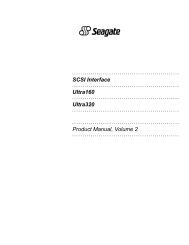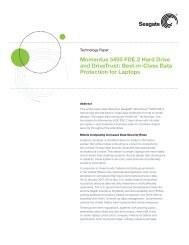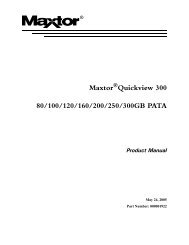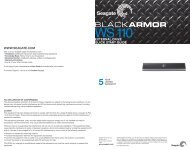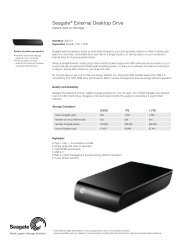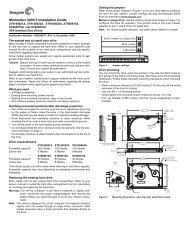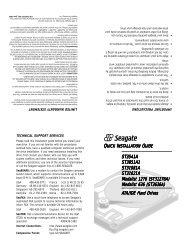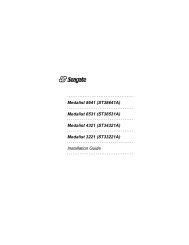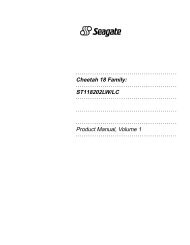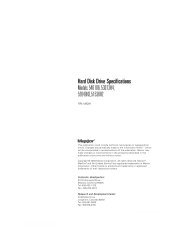Barracuda 18LP Family: ST39175LW/LC ST318275LW ... - Seagate
Barracuda 18LP Family: ST39175LW/LC ST318275LW ... - Seagate
Barracuda 18LP Family: ST39175LW/LC ST318275LW ... - Seagate
Create successful ePaper yourself
Turn your PDF publications into a flip-book with our unique Google optimized e-Paper software.
10 <strong>Barracuda</strong> <strong>18LP</strong> Product Manual, Rev. E<br />
SCSI interface data transfer rate (asynchronous) [5]:<br />
Maximum instantaneous 3.5 Mbytes/sec [6]<br />
Maximum average 3.5 Mbytes/sec [7]<br />
Synchronous transfer rate for SCSI Fast-20 (Ultra-1 SCSI):<br />
16 bit data bus models 40 Mbytes/sec<br />
Synchronous transfer rate for SCSI Fast-40 (Ultra-2 SCSI):<br />
16 bit data bus models 80 Mbytes/sec<br />
Synchronous transfer rate for fast SCSI-2:<br />
16 bit data bus models 20 Mbytes/sec<br />
Sector Sizes:<br />
Default<br />
512 byte user data blocks<br />
Variable 512 to 2,048 bytes per sector in multiples of 2<br />
bytes per sector.<br />
If n (number of bytes per sector requested) is<br />
odd, then n–1 sectors will be used.<br />
Read/write consecutive sectors on a track Yes<br />
Flaw reallocation performance impact (for flaws reallocated at format time using<br />
the spare sectors per sparing region reallocation scheme.)<br />
Overhead time for head switch in sequential mode<br />
Average rotational latency<br />
Negligible<br />
1.0 msec<br />
4.17 msec<br />
Notes for Section 4.2.<br />
[1] Execution time measured from receipt of the last Byte of the Command Descriptor Block (CDB) to the<br />
request for a Status Byte Transfer to the Initiator (excluding connect/disconnect).<br />
[2] Maximum times are specified over the worst case conditions of temperature, voltage margins and drive<br />
orientation. When comparing specified access times, care should be taken to distinguish between typical<br />
access times and maximum access times. The best comparison is obtained by system benchmark tests<br />
conducted under identical conditions. Maximum times do not include error recovery.<br />
[3] Typical Access times are measured under nominal conditions of temperature, voltage, and horizontal orientation<br />
as measured on a representative sample of drives.<br />
[4] Assumes no errors and no sector has been relocated.<br />
[5] Rate measured from the start of the first sector transfer to or from the Host.<br />
[6] Assumes system ability to support the rates listed and no cable loss.<br />
[7] Simulated.<br />
[8] Access time = controller overhead + average seek time<br />
Access to data = controller overhead + average seek time + latency time<br />
4.3 Start/stop time<br />
After DC power at nominal voltage has been applied, the drive becomes ready within 25 seconds if the Motor<br />
Start Option is disabled (i.e. the motor starts as soon as the power has been applied). If a recoverable error<br />
condition is detected during the start sequence, the drive executes a recovery procedure which may cause the<br />
time to become ready to exceed 25 seconds. During spin up to ready time the drive responds to some commands<br />
over the SCSI interface in less than 1.5 seconds after application of power. Stop time is less than 20<br />
seconds from removal of DC power.<br />
If the Motor Start Option is enabled, the internal controller accepts the commands listed in the SCSI Interface<br />
Product Manual less than 3 seconds after DC power has been applied. After the Motor Start Command has<br />
been received the drive becomes ready for normal operations within 13 seconds typically (excluding an error<br />
recovery procedure). The Motor Start Command can also be used to command the drive to stop the spindle<br />
(see SCSI Interface Product Manual, part number 77738479).<br />
There is no power control switch on the drive.



